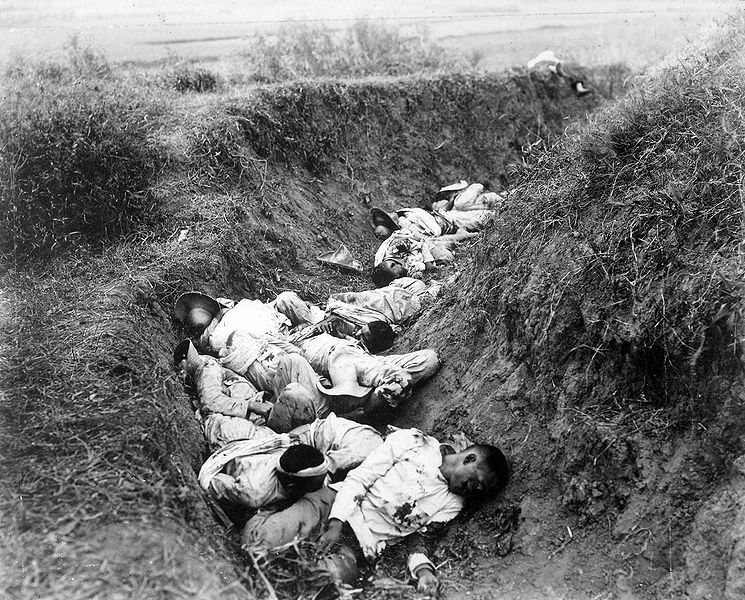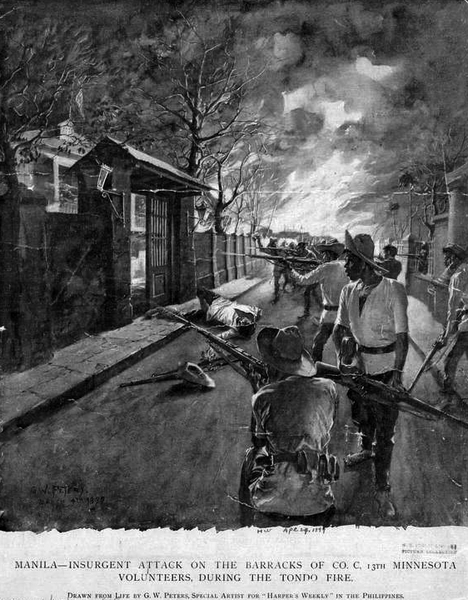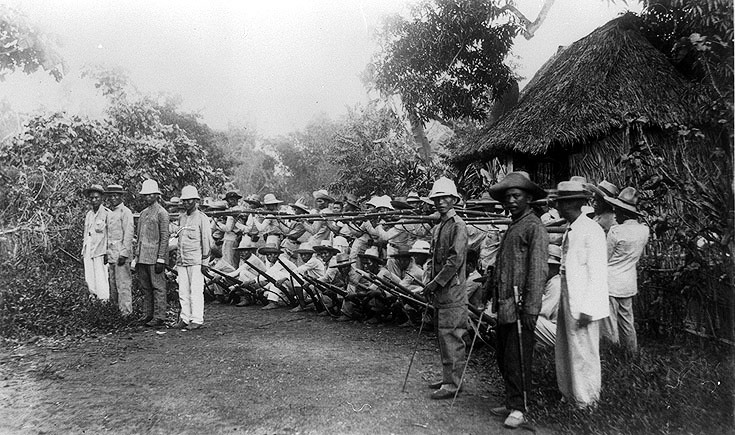100 years ago, the United States was ceded the Philippine Islands after a "Splendid Little War" with Spain. The United States saw the economic and military importance of the islands, but they had trouble convincing their "Little Brown Brothers" of the benefits of annexation. On February 4, 1899, the first shots of the Philippine-American War were fired. It was a war that would drag on for over three years and cost unknown thousands of lives. It was one of the bloodiest conflicts in American history, and the country has tried hard to forget it. Our mission was to create a webpage which provides a clear explanation of the war.
The Philippine conflict was a new kind of war for Americans. It has been called the first Vietnam, a guerrilla war fought on distant soil against a foreign people, over the right to self government. Against these "savages", frustrated American troops often abandoned civilized warfare, and brutality rose to the level of the contemporary conflicts in Cuba and South Africa.
All you say about the Philippines, the conflict there between the Americans, military and civil, and the pig headedness of the military and their habits of setting "bulldogs to catch rabbits" is immensely cheering to me, because it is precisely what we are doing in South Africa.
--Rudyard KiplingIn the 1890's, America was a country looking to test its might against the imperial powers of Europe. The spirit of Manifest Destiny lived on, and many were looking to expand the nation's influence overseas. Many Americans saw it as their duty to carry the "White Man's Burden" to the far shores of less civilized nations. In 1898, the United States annexed Hawaii after several years of occupation. Unfortunately, annexing the Philippines guaranteed the occupants no part in United States government -- America had no wish to acquire another state, but a colony.
Not all Americans supported the war in the Philippines. While the Anti-Imperialists were a small group, they were both vocal and distinguished. Their reasons for opposing the annexation ranged everywhere from belief in the higher ideals of liberty and democracy, to fear that "lesser races" would further pollute their country. Unfortunately, the voices against imperialist policies went largely unheard, lost amidst cries of expansion and war.
The White Man's BurdenTake up the White Man's burden
Send forth the best ye breed
Go, bind your sons to exile
To serve your captives' need:
To wait, in heavy harness,
On fluttered folk and wild
Your new-caught sullen peoples,
Half devil and half child.
--Rudyard Kipling+++
The War PhaseIn 1896, a young Filipino named Emilio Aguinaldo, leader of the Katipunan, led yet another of these uprisings, in response to the execution of the national hero José Rizal . This rebellion ended with the Biak-na-Bato Pact in December of 1897, which exiled Aguinaldo and his followers to Hong Kong. But their exile was not to last. On April 25, 1898, the United States declared war on Spain, and on May 1, U.S. Commodore George Dewey defeated the Spanish fleet in the Battle of Manila Bay. Aguinaldo returned to Manila twelve days later aboard the USS McCullock and immediately resumed revolutionary activities against the Spaniards, under the encouragement of the United States. The revolution was a success, and on June 12, 1898, the Philippines, with Aguinaldo as leader, declared themselves independent from Spain.
The remaining Spanish were driven into Manila and surrounded by Filipino troops. In August 1898 the Siege of Manila ended with the surrender of the Spanish to the Americans, who occupied Manila and barred access to the Filipinos. On August 22, General Elwell Otis arrived to replace General Merritt and become the first Military General of the Philippines. Otis refused to even negotiate with the Filipinos, and in spite of Aguinaldo’s attempts to maintain peace, tensions mounted between the two armies.
The Treaty of Paris, which granted possession of the Philippines to the United States, was signed on December 10, 1898. The treaty sparked bitter debate in the U.S. between imperialists and anti-imperialists. Later that month President McKinley issued his "benevolent assimilation" proclamation, to "announce and proclaim in the most public manner that we come not as invaders or conquerors, but as friends..." making it clear that the United States would not grant the Filipinos their long-sought independence. This further increased the strain between armies, and on February 4, 1899 the first shots of the war were fired by American soldiers. On February 5, the Filipinos were forced to retreat northward after heavy losses. The Treaty of Paris was ratified by congress the next day, giving official ownership of the islands to the United States.
Aguinaldo’s troops slowly lost ground in the following months and fled further from Manila. However, American conquest wasn’t limited to Luzon. On February 22, Cebu City on the island of Cebu and Iloilo on Panay both fell to American troops. But American victories were limited. On Luzon, American troops had made little progress. By early summer of 1899, more time than the entire Spanish-American War, American troops had only conquered thirty miles north and south of Manila. American forces were victorious at the Battle of Calumpit, but it wasn’t the devastating victory that Otis had hoped for before the rainy season. With this in mind, he undertook to destroy Filipino forces in the Battle of Cavite in early June. The Americans won, but the majority of Filipinos evaded the American trap and escaped south.
On June 12, Filipino General Antonio Luna, long time rival of Aguinaldo, was murdered by fellow Filipinos. His loss was another great blow to the already faltering Filipino army. Americans continued to defeat Aguinaldo’s army, pushing him farther north, and in December almost had him surrounded. He escaped through the courageous actions of Gregorio del Pilar, who covered his retreat at Tirad Pass. The Americans failed to capture Aguinaldo, but Pilar was killed and 1,100 Filipinos surrendered under the command of Colonel Danilo Tirona soon after. Two weeks later, American General Henry Lawton was killed in the Battle of San Mateo outside Manila.
Successive Filipino defeats weakened and demoralized the army, and in early 1900, Aguinaldo decided to abandon conventional warfare and switch to guerrilla tactics. Americans were also busy outside of Luzon; on March 17, 1900, American forces occupied the island of Bohol. The phantom Filipino forces frustrated the Americans across the archipelago by avoiding large confrontations; progress slowed drastically and General Otis was replaced as Military Governor by Arthur MacArthur on May 2, 1900.
With war raging, the Taft Commission arrived in June to set up a civilian government. This offered a new option to the beleaguered Filipinos, some of whom, after witnessing the superior military strength of the Americans, decided they had had enough of war and set up the Partido Federal to cooperate with the United States. On February 2, 1901, the same day as the formal inauguration of the Partido Federal, the Filipino forces in Panay surrendered. An even greater victory for the Americans came on March 8, at the Battle of Lonoy on Bohol. On March 15, Mariano Trias, Aguinaldo's second in command, surrendered to the Americans with 130 Caviteño troops. He claimed that "the people were demanding peace" and called on all other Filipinos to surrender to the benevolent Americans.
On Luzon, the resistance suffered a near fatal blow with Aguinaldo's capture by Colonel Frederick Funston. He was kept prisoner for several weeks before capitulating and taking an oath of allegiance to the United States. Many generals surrendered with Aguinaldo, but the resistance survived in pockets about the islands, most notably in the province of Batangas in southern Luzon. There, General Miguel Malvar took over Aguinaldo’s former position in July and continued the resistance. Soon after Aguinaldo’s capture, American leadership changed yet again, when MacArthur transferred his powers as governor to Taft, and his military powers to Gen. Adna Chaffee on July 4. Chaffee’s “Injun fighting†policies were greeted enthusiastically by American soldiers, as well as by Theodore Roosevelt, who became President on September 6, after the assassination of McKinley.
Resistance survived on the island of Samar, where the most famous incident of the war, the Balangiga Massacre, occurred on September 26, 1901. This surprise attack, masterminded by Filipino General Vincente Lukban, was half successful, though more Filipinos died in the fighting than Americans. This “massacre†enraged American troops, who then initiated a policy of “kill and burn,†under the leadership of Gen. Jacob Smith. In October, the nearby island of Cebu surrendered to American troops, and was followed by Bohol in December. But some of the events in the Philippines were starting to draw public attention, and in January of 1902, a Senate committee was formed to investigate the war. In February, Lukban was captured, and resistance on Samar ended soon after.
Meanwhile, the war was winding to a close in Luzon, where Gen. Franklin Bell had set up the infamous “zones†under orders from Chaffee. The entire civilian population was herded into select cities which served as prison camps, and everything outside the zones was systematically destroyed. On April 16, 1902, Malvar surrendered to the American forces. On July 4, 1902, President Roosevelt issued the official Peace Proclamation ending the war and granting pardon to the insurrectos.
The Philippine-American war was over, but the story of the Philippines was not. Even as the war was ending, American commanders Waller and Smith, among others, were put on trial for war crimes. In the southern islands of Mindanao and Jolo, American troops continued to fight the Moros for another eleven years. The northern islands were slowly Americanized, gaining schools, roads, sanitation, and an American-based government system. After World War II, on July 4, 1946, the Philippines were finally granted independence.
Casualties
The United States of America4,324 U.S. soldiers dead, 3,000 wounded
2,000 killed, dead, or wounded suffered by the Philippine Constabulary
The First Republic of the Philippines (Malolos Republic)16,000 soldiers killed
est. 250,000 to 1,000,000 civilians died of war (through combatants of both sides), famine, or disease.
++++++++

Philippine Revolutionary Army soldiers: After the battle of Manila

Philippine Revolutionary Army


Philippine Revolutionary Army
Linkback:
https://tubagbohol.mikeligalig.com/index.php?topic=4366.0